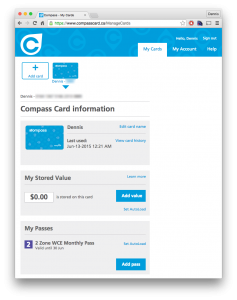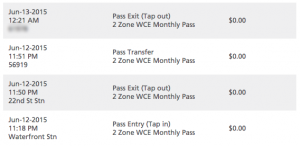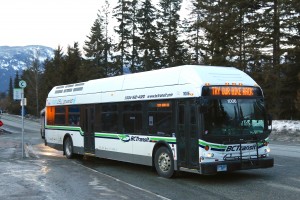Almost two years after the Beta Test, the Compass Card is finally starting to become within reach of the general public.
The Compass Card was first rolled out for BC Bus Pass, TransLink employees and CNIB passengers in January 2014. The U-Pass BC started transitioning to Compass early this year. This past week, the Compass Card was made available for West Coast Express customers.
TransLink staff were handing out Compass Cards at the Waterfront West Coast Express station this week, so I went to get one on my lunch break.
For the past week, I’ve been tapping in and out. For the most part I can’t really see anything significantly different from the beta test. The readers on the buses emit a louder beeping sound, which is great. I’ve still run into the occasional frozen faregate. And the transition on the readers from “Tap In” To “Proceed” is still green to green (one of the complaints was that it was difficult to see the change to “Proceed”).
All in all, it’s great to see that after two years we finally may see the Compass Card fully in use.
The Compass Card Website
This is one part of the Compass Card project that wasn’t ready during the Beta Test.

The Compass Card website is very easy to use and mobile friendly. I was able to register the card and purchase a monthly pass through my mobile browser with no issues.
Side note: If any of you use a three-zone monthly bus pass for $170, did you know you can actually save almost $20 by purchasing the cheapest West Coast Express monthly pass for $151.75, which includes unlimited bus/SkyTrain/SeaBus travel.

The website also shows when you tapped in and tapped out. This means that information is inherently logged and identifiable by each Compass Card.
From TransLink’s perspective, this information is great as it is much more specific than the passenger counters that it currently employs. Also it provides TransLink information as to the actual start and destinations of trips instead of just boardings. This can definitely aid in planning routes and services that better cater to the actual demand.
However on the other hand, this raises privacy concerns. If you have registered your Compass Card with TransLink (which they recommend for extra benefits like auto-loading of funds and balance protection if you lose your card), this means that TransLink has the data to track all of your movements on public transportation. We can take a look at the Compass Card privacy policy for some reassurance though. Here are some quotations from the document.
On anonymity if you don’t register your card:
Unless you choose to share personal information with us, you’ll be anonymous. You don’t have to register your card, but if you decide to, we’ll require some information, so we can provide assistance and services.
Usage of travel data for planning purposes:
Anonymous and aggregated travel data (i.e., amassed data stripped of personal information) will be studied by TransLink to better understand, plan and forecast ridership volumes and transit service. This data will help shape better transportation for the region and provide new and better products and services in the future.
How long travel data is associated with your Compass Card:
We’ll keep your Compass Card transactions for 15 months so that, if you’ve registered your card, you can easily access 15-months’ worth of transactions online. After 15 months, your personal information is stripped from your travel details.
That should ease the minds of most people who may be concerned about privacy; giving the privacy policy a complete read is probably a good idea anyway. And of course if you don’t register your card, you will remain anonymous.




